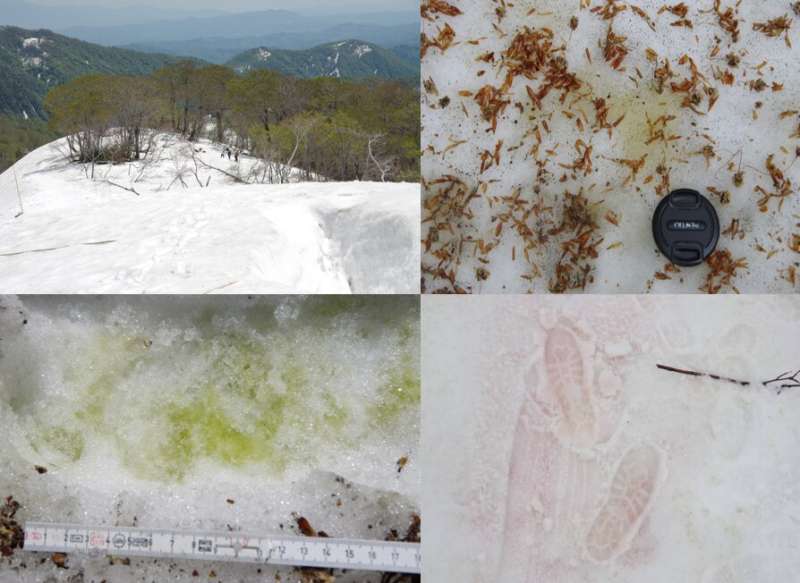This article has been reviewed according to Science X's editorial process and policies. Editors have highlighted the following attributes while ensuring the content's credibility:
fact-checked
proofread
Investigating the growth of snow algal blooms on Mount Gassan, Japan

Rising temperatures have led to the growth of algal blooms in water bodies, mountainous areas, and coastal regions as far as the Arctic. Recently, pigmented snow algae have been spotted on Japan's Mount Gassan after the winter season. The presence of such algal blooms is concerning because they reduce the reflectivity of snow-covered surfaces, resulting in faster snow melting.
Additionally, the algal blooms can have unforeseen impacts on the surrounding wildlife and vegetation. The growth and color of snow algae in mountainous areas appear to differ depending on the season, elevation, and predominant vegetation. However, there is limited information on the appearance of algal blooms in the mountainous areas in Japan.
The appearance of snow algal blooms on Mount Gassan caught the attention of Nozomu Takeuchi, a Professor in the Department of Earth Sciences at Chiba University, Japan, who has decades of experience studying organisms in snowpacks and glaciers around the world. Together with Suzuki Takumi from the same faculty, Prof. Takeuchi documented the growth and composition of such blooms at different elevations on Mount Gassan.
Their findings, which were published in the journal Arctic, Antarctic, and Alpine Research, on March 13, 2023, shed light on the growth and spread of snow algal blooms in the mountainous regions of Japan.
"Although Japan has exceptionally high levels of snowfall, the presence of such organisms living in snowpacks remains unknown. This study may induce people to acknowledge the precious ecosystems in the mountains of Japan," says Prof. Takeuchi, explaining the motivation behind their study.
The algal blooms in Mount Gassan typically appear from late March to mid-July, which is after the winter season when the snow starts to melt. During this period, the researchers collected colored snow samples at seven different locations on Mount Gassan. The locations spanned a range of altitudes, from 780 to 1656 meters above sea level (a.s.l), encompassing heavily forested areas at lower altitudes and alpine grasslands at higher elevations.
The effects of both season and altitude on algal blooms became quickly apparent during the sampling phase. In May, the researchers observed mostly green-colored snow at lower elevation sites (180–1,016 m a.s.l). In June, the green-colored snow was found further up the mountain, and patches of red-colored snow were found at the highest survey location, at an elevation of 1,656 m a.s.l.
By July, the algal blooms on this site had multiplied, resulting in the researchers finding numerous patches of red-colored snow. This trend indicates that algal growth begins in the lower forested areas and spreads to the upper alpine zone as the seasons get warmer. Their observation was confirmed by laboratory chlorophyll analysis, which revealed that chlorophyll-a concentration in the snow samples collected across the different sampling sites increased from May to July.
To find out why this happens, the researchers analyzed the snow samples for soluble chemical ions. Their findings revealed that the concentration of algal blooms corresponded with the presence of nutrients associated with the growth of algal blooms, such as phosphate (PO43−), ammonium (NH4+), and potassium (K+), which were found to originate from plant litter, particularly shed bud scales that were noticed on the snow surface during sample collection.
These shed bud scales are a common occurrence during the budburst of deciduous trees, a phenomenon wherein the scales that protect the buds during winter are shed and fall to the ground during the spring and summer months. This was confirmed by satellite images of the tree cover, which revealed the expansion of the forested areas of the mountain from May to July.
"Our investigations revealed that snow algal blooms develop across the elevational range from the lower forested areas to the upper alpine zone during the melting season, and that the emergence of algal blooms is strongly associated with springtime vegetation and tree phenology," explains Prof. Takeuchi.
Warmer global temperatures are likely to make algal blooms more prevalent in the mountains. Understanding how these blooms grow and spread can help us become more resilient to the effects of climate change. This is also important for predicting and ameliorating the effects of global warming on vulnerable ecosystems like the cryosphere and associated wildlife in Japan and the rest of the world.
More information: Takumi Suzuki et al, Influence of vegetation on occurrence and color of snow algal blooms in Mt. Gassan, Yamagata Prefecture, Japan, Arctic, Antarctic, and Alpine Research (2023). DOI: 10.1080/15230430.2023.2173138
Provided by Chiba University





















